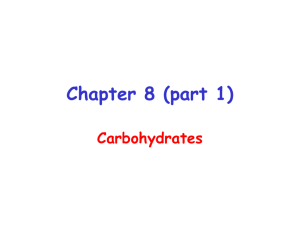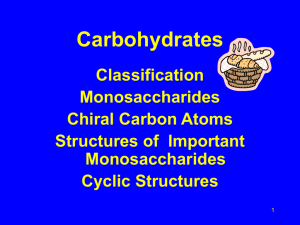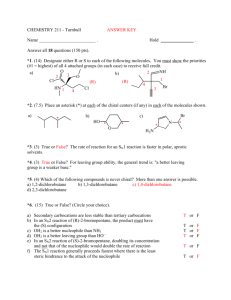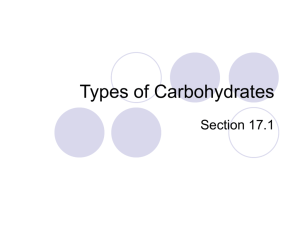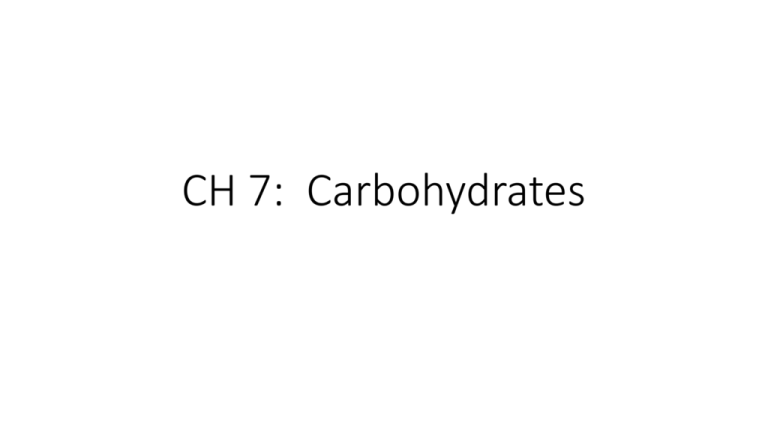
CH 7: Carbohydrates
First Biochemistry Chapter
• Biochemistry – study of substances found in living organisms
and their interactions with each other
• Most important branch of science in medicine
• Substances can be bio-inorganic or bio-organic
• Bio-inorganic = water, ions, and ionic compounds
• Bio-organic:
• Carbohydrates: C, H, O
• Lipids: C, H, O
• Proteins: C, H, O, N, S
• Nucleic Acids: : C, H, O, N, P
Carbohydrates
• Carbohydrates are the most abundant bio-orainc substance
on the planet
• Made by photosynthetic (PHS) organisms
• PHS reaction – see board
• Plants use the carbs made for 2 (really 3) purposes:
1. Source of energy – glucose (not a separate purpose in text)
2. Make starch – storage form of glucose
3. To make cellulose – structural polysaccharide found in cell walls
Functions of Carbohydrates in Animals
1. Source of energy - glucose
2. Storage form of energy – glycogen
• Made and stored in liver and muscles
3. Use carbons to make other bio-organic substances
4. 5 Carbon sugars are key component of DNA and RNA
• Deoxyribose – DNA
• Ribose – RNA
5. Short, often branched carbohydrates attach to proteins and lipids
on the outside of the plasma membrane
• Called glycoproteins and glycolipids
Classifying Carbohydrates
• Carbohydrate = polyhydroxyl aldehyde or ketone
• Aldehyde carb = aldose sugar*
• Ketone carb = ketose sugar*
* monosaccharides and disaccharides are also referred to as sugars
Classes of Carbohydrates
1. Monosaccharides – single polyhyroxyl ald/ketone unit
2. Oligosaccharides – 2-~10 monos. units joined by covalent
bonds, may be branched
• Disaccharides – 2 monos. units joined by covalent bond
• Sucrose, lactose, maltose, cellobiose
3. Polysaccharides – MANY monos. units joined by covalent
bonds
• Glycogen
• Starch – amylose and amylopectin
• Cellulose
Chiral Compounds
• Many carbohydrates are chiral compounds
• Chiral objects have mirror images that are cannot be
superimposed (like your hands).
• Chiral compounds have the same number of atoms
arranged differently in space.
• A chiral carbon atom has four different groups attached
• Called a chiral center
• Page 238
7
Determine if there is a chiral carbon in each compound.
8
? Chiral Carbons ?
D and L Notation - Cabohydrates
• D,L tells which of the two chiral isomers of a carbohydrate
we are referring to.
• If the –OH group on the next to the bottom carbon atom
points to the right , the isomer is a D-isomer; if it points left,
the isomer is L.
• The D form is usually the isomer found in nature.
10
D or L ?
11
Fischer Projections
• Simplified way to show chiral centers
Draw Fischer Projection for…..
Terms
• Chiral center (carbon)
• Chiral compound – non-superimposable mirror images
• chiral center present
• Achiral compound - superimposable mirror images
• no chiral centers
New Types of Stereoisomers
• Enantiomers – stereoisomers with non-superimposable
mirror images
• Diastereomers – stereoisomers that are not mirror images
• Cis-trans isomers fit here as well as the carb isomers we’re
working on
• Epimers – diastereomers that differ at just one chiral center
Examples……
• See board for examples…then from the book, COVER answers
• 7.2 – example or practice exercise
• 7.3 – “ “
• 7.4 – both example and practice exercise
• Page 246 may be useful
Properties of Enantiomers
• Constitutional isomers differ in most chemical and physical
properties
• Enantiomers (a stereoisomer) have the same:
• Boiling points, melting points
• Density
• Solubility and reactivity with achiral compounds
• Enantiomers differ in:
• Rotation of polarized light
• Solubility in chiral solvents
• Reactivity with chiral reactants
Chiral Compounds and Polarized Light
Enantiomers and Polarized Light
• Enantiomers are optically active – rotate polarized light
• May rotate in clockwise or counter-clockwise direction
• Clockwise rotation = Dextrorotary (+)
• Counter-clockwise rotation = Levorotary (-)
• D & L enantiomers rotate light in opposite directions
• Which direction they rotate is unrelated to the D/L designation
and must be determined experimentally
• The degree of rotation depends on the concentration of the
solution and the identity of the substance.
Monosacchrides - describing
• Aldoses sugars are monosacchrides with an aldehyde group
and many hydroxyl (-OH) groups.
• Ketoses sugars are monosacchrides with a ketone group and
many hydroxyl (-OH) groups.
20
Monosacchrides - describing
• Three Carbons =
Triose
• Four Carbons =
Tetrose
• Five Carbons =
Pentose
• Six Carbons =
Hexose
• Page 251
21
Identify each as tetrose, pentose or hexose, and as
aldose or ketose, D or L?
22
Hexose Monosaccharides
CH2OH
CHO
H
HO
OH
C H O
O
H
O H
HO
H
H O
H
H
OH
H O
H
H
OH
H
CH2OH
D-Glucose
(aldohexose)
O H
C H
2
D-Galactose
(aldohexose)
OH
H
H
OH
H
OH
CH2OH
D-Fructose
(ketohexose)
D-Glucose
CHO
H
HO
OH
H
H
OH
H
OH
•Also called blood sugar or dextrose*
•70 - 100 mg/100 mL of blood
•All other nutritionally important sugars
are converted to glucose in the liver.
•Forms a 6 membered cyclic hemiacetal
CH2OH
D-Glucose
(aldohexose)
* Name related to the clockwise
rotation of light
D-Galactose
• D-galactose is an epimer of D-glucose
• Rarely found as free monos. in nature
• Find in Lactaid milk
• Not very sweet
CHO
H
OH
HO
H
HO
H
H
OH
• Find galactose as a component of glycoproteins CH2 OH
D-Galactose
on brain and other nerve cells, also an
(aldohexose)
important carbohydrate in blood typing
D-Fructose
• Also known as fruit sugar and levulose
• Rotates polarized light counter-clockwise
• Sweetest of all monosacharides
• High fructose corn syrup
• Glucose and fructose differ in just the location
of the carbonyl group
CH2OH
O
HO
H
H
OH
H
OH
CH2OH
D-Fructose
(ketohexose)
D-Ribose & D-Deoxyribose
• Pentose Sugars – not nutritionally important
• Components of RNA and DNA
in hemiacetal (cyclic) forms
Hemiacetal Formation – Cyclic Carbohydrates
• Monosaccharides form cyclic hemiacetals
• Formation of the hemiacetal
• Alpha versus beta form (anomers)
• Showing structure – Haworth projections
• Chiral OH on right goes down on structure
• Chiral OH on left goes up on structure
Cyclic Hemiacetal Forms of D-Glucose
2 forms of cyclic D-glucose:
• Alpha-form: -OH of C1 and CH2OH of C5 are on
opposite sides
• Beta-form: -OH of C1 and CH2OH of C5 are on
6
6
same sides
CH OH
CH OH
2
5
4
OH
2
O
1
OH
2
3
OH
OH
4
OH
O
OH
2
3
OH
-D-Glucose
Copyright © Cengage Learning.
All rights reserved
5
-D-Glucose
30
OH
1
Glucose in solution
CHO
H
HO
H
H
6
6
OH
CH2OH
CH 2OH
H
5
OH
OH
CH2OH
D-Glucose
(aldohexose)
Less than .01%
4
OH
O
1
OH
2
3
OH
OH
-D-Glucose
37% glucose
5
4
OH
O
OH
2
OH
1
3
OH
-D-Glucose
63% glucose
D-Ribose
D-Fructose
CH2OH
O
HO
•Forms a 5 membered cyclic form
H
H
OH
H
OH
CH2OH
CH2OH
D-Fructose
(ketohexose)
CH2OH
O
CH2OH
O
OH
OH
OH
OH
-D-Fructose
OH
OH
-D-Ribose
Skip 7.12 (for now!)
Disaccharides
• Monosaccharides in their cyclic form react to form
acetals……aka…disacharrides or a glycoside
• Bond is called a glycosidic linkage
• Disaccharides we will consider:
1. Maltose
2. Cellobiose
3. Lactose
4. Sucrose
• Goal is to:
• Know constituent monosaccharides
• Recognize type of bond
• Know how body handles – digestible or not?
• Identify sugar as a reducing sugar or not
• Page 262
Formation of Maltose
Maltose
CH2 OH
CH2 OH
O
O
OH
OH
O
OH
OH
OH
• - D –glucose -- D-glucose
Copyright © Cengage Learning.
All rights reserved
OH
(1-4)
37
Cellobiose
• - D –glucose -- D-glucose
CH2OH
O
(1-4)
CH2OH
O
H
OH
O
OH
OH
OH
OH
Cellobiose
Copyright © Cengage Learning.
All rights reserved
38
OH
Lactose
• - D –galactose -- D-glucose
CH2OH
CH2OH
O
OH
O
(1-4)
H
OH
O
OH
OH
OH
Lactose
Copyright © Cengage Learning.
All rights reserved
39
OH
Sucrose – , (1->2) linkage
CH2 OH
O
CH2 OH
OH
O
OH
OH
OH
OH
-D-Glucose
OH
OH
+
CH2 OH
, (1->2) linkage
OH
O
CH2 OH
OH
O
(1-2)
Linkage
O
OH
CH 2OH
OH
-D-Fructose
CH 2OH
OH
Sucrose
Polysaccharides - Consider
1. Sugars present in polymer
•
Homopolysaccharide or heteropolysaccharide
2. Length of chain
3. Extent of branching
4. Type of linkage between monomers and at branch points
Polysaccharides
1. Starch
• Amylose
• Amylopectin
2. Glycogen
3. Cellulose
4. Chitin (not covered)
Starch
• Starch:
• Polymer of glucose
• Storage form of glucose in plants
• Two forms
• Amylose
• Amylopectin
Copyright © Cengage Learning.
All rights reserved
43
Amylose
• 15 - 20% of starch
• Straight chain polymer
• coils
• Up to ~1000 glucose units
• (1 4) glycosidic bonds
Amylopectin
• 80 - 85 % of the starch
• Branched chain polymer of glucose
• (14) glycosidic bond for straight chain and
(16) at the branch
• Branch every ~25-30 glucose
• up to 100,000 glucose units
• Humans can hydrolyze alpha linkages in starch
Glycogen
• Polymer of glucose, up to 1,000,000 glucose
units
• Excess glucose in blood stored in the form of
glycogen – animal storage form of glucose
• Bonding?
• Branch every ~8-12 glucose
• ~2-3x more branched than amylopectin
Cellulose
HO
O
HO
O
HO
O
HO
O
O
O
(1-4)
OH
OH
O
(1-4)
OH
O
(1-4)
OH
OH
OH
OH
OH
• Structural polysaccharide – made by plants, bacteria, and
others (not humans)
• Straight chain polymer of glucose, up to ~ 5,000 glucose
units
• (1 4) glycosidic bonds between glucose
• Humans don’t have enzymes that hydrolyze (1 4) - so
humans cannot digest cellulose
O
Cellulose chains crosslink with H bonds to form
bundles/fibers
– Cotton ~95% cellulose and wood ~50% cellulose
Reactions of Monosaccharides
Oxidation Reactions (3)
1. Mild oxidizing agent such as Tollen’s or Benedict’s
o
All monosaccharides and disaccharides except sucrose
react – called reducing sugars
o
Hemiacetal group opens to reform the aldehyde or ketone group
o
o
o
Ketone group rearranges to form an aldehyde
Reaction oxidizes the aldehyde to a carboxylic acid
No hemiacetal to open in sucrose
Oxidation of Monosaccharides
2. Strong oxidizing agents can oxidize both ends of a monosaccharide
•
the carbonyl group and the terminal primary alcohol group oxidize to
produce a dicarboxylic acid.
3. Enzymes can oxidize the primary alcohol end of an aldose such as
glucose, without oxidation of the aldehyde group!
•
VERY difficult to do in the lab
Reduction to a Sugar Alcohol
• The carbonyl group in a monosaccharide (either an aldose or a
ketose) is reduced to a hydroxyl group using hydrogen as the reducing
agent.
• The product is the corresponding polyhydroxy alcohol - sugar alcohol.
• Sorbitol
CHO
H
HO
OH
H
H
OH
H
OH
CH2OH
D-Glucose
(aldohexose)
Sorbitol
Reactions of Monosaccharides
• Glycoside formation – already covered
• Hemiacetal of one carb. Reacts with an alcohol group on another carb to
produce a glycosidic linkage/bond


